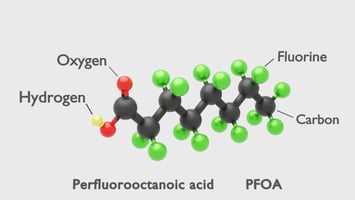We in the outdoor industry are in the process of switching to non-fluoride materials and water...
Is fluoride bad for you? What is the toxicity of fluoride in toothpaste? [Inorganic fluoride]
You may have heard that fluoride is bad for your health, but you may also have seen that it is used in toothpaste, to prevent pans from sticking, and in waterproofing sprays for rainwear and skiwear.
Is it safe to use these products? Are we already experiencing the harmful effects? In this article, we will explain in detail.
*I am not a doctor. In this article, there are some parts that are explained from a medical perspective, but these are based on the scientific knowledge I have gained through my research and development of fluoropolymers. If you find any medical errors in the explanations, please let me know.
There are many misconceptions about the idea that “fluorine is bad for you”
I think that there are actually many misconceptions about the idea that fluorine is bad for you.
I think that the correct understanding is that some things are bad for you, but others are not. The idea that all fluorine is bad is a very broad generalization. In this article, I would like to explain what is bad for you and what is not, and how it can even be beneficial.
There is not much point in talking about the fluorine element on its own
You may have heard that fluorine is a highly poisonous substance. It is true that there are dangerous gases and aqueous solutions called fluorine gas and hydrofluoric acid. This is why there is a misconception that fluorine is dangerous and bad for the body. Let's explain this in a little more detail.
For example, chlorine is not dangerous.
If we say that fluorine is dangerous, then chlorine would also be dangerous. When chlorine exists as a gas, it can irritate the eyes and skin of humans, and depending on the amount inhaled, it can even be fatal. Chlorine gas can occur quite easily, for example, if you mix toilet cleaner and sodium hypochlorite (bleach) to remove mold, chlorine gas can be produced. Other aqueous solutions such as hydrochloric acid are also dangerous.
However, there are many substances around us that contain chlorine. Polyvinyl chloride contains chlorine, and it is sometimes used as a material for building materials such as ducts and rain gutters, food wrap film, and children's boots and erasers.
And the most familiar substance that contains chlorine is table salt. Not only do we use it in our everyday lives, it is also an essential nutrient that we actively take into our bodies.
It is necessary to judge each compound, not just the element
As you can see, it is not possible to talk about all the things that contain the chlorine element in the same way. The properties of each one differ greatly depending on what element it is combined with.
Just as chlorine compounds can be harmful, or used in everyday life, or even consumed as food, the same can be said of fluorine compounds.
Fluorine also exists in nature
Fluorine exists in nature, and is not harmful in itself. It is mainly mined in China as fluorite, and is used in various fields as a fluorine compound today. Fluorite itself is mainly composed of calcium fluoride.
In addition, it also exists in water as fluoride ions (F-). These are different from the fluorine gas (F2) we have already discussed, and they are also called fluorine ions.
Fluoride ions also exist in food
Fluoride ions are also contained in many foods, and we are consuming them without realizing it.
For example, seaweed, seafood and tea contain several times more fluoride ions than other foods. Other foods also contain fluoride ions, although not necessarily in large quantities.
Are fluoride ions bad for the body?
So, do the fluoride ions that we are unknowingly consuming have a negative effect on our bodies?
The answer to this is both yes and no. Fluoride ions are recognized as a nutrient that needs to be consumed in small amounts. This is called an essential trace nutrient. Other essential trace nutrients include iron, copper and zinc. In recent years, it is also sometimes taken in supplements. Fluorine is known to be an essential element in the calcification that forms strong bones and teeth in our bodies.
On the other hand, it is also important to be careful not to take in too much fluoride ion. If you take in too much fluoride ion, you may develop fluorosis of the teeth or fluorosis of the bones.
This is also true of other nutrients. It is well known that too much salt, which we are all familiar with, is bad for you. Furthermore, the effect on the body also depends on how much you have consumed in a short period of time, or how much you have consumed on a regular basis, even if it is a small amount. The same can be said for fluoride ions.
Is fluoride in toothpaste bad for you?
What about the fluoride contained in toothpaste? Like fluoride ions, if used in the right amount, it can help to form healthy teeth. However, the amount that can be ingested differs depending on age, and small children need to be careful about excessive intake.
For example, the WHO does not recommend the use of fluoride mouthwashes (mouth rinses) for children under the age of 6. It is easy to think that toothpaste with fluoride is bad for children, but this is a misconception. The reason that mouthwash with fluoride ions was not recommended is that the concentration of fluoride ions in mouthwash is high, and in the case of children, there is a risk that they may accidentally swallow it when gargling, and in that case, it is easy to overdose on fluoride ions. Because the concentration of fluoride ions used in toothpaste is not very high, it is recognized that the use of toothpaste containing fluoride ions is effective for small children. In Japan, it seems that the use of mouthwash is also recognized as being safe for children aged 4 and over.
As you can see, research has shown that fluoride, or fluoride ions, contained in toothpaste are effective for dental calcification if used in normal amounts, without excessive intake.
Is the fluoride in frying pans and waterproofing sprays bad for you?
Next, I would like to write about the fluoride used in frying pans and waterproofing sprays, but this is a completely different topic to the one we have been discussing so far, and it would be just as long as this article, so I will expand on it in a separate article. Even if we just say 'fluoride', there are differences, and it is difficult to talk about them all together.



